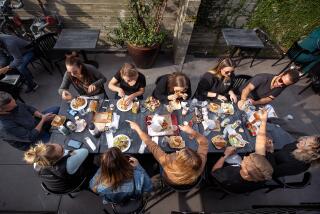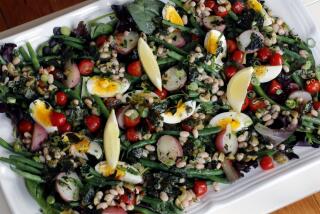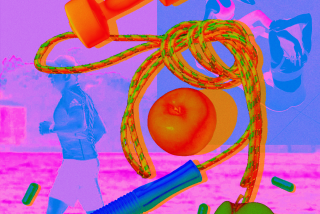Chew On This: Food-Related Thoughts
Here are several small items that give us all food for thought:
Losing Weight
Ever wonder why itâs so hard to lose weight? One pound of body fat will yield 3,500 calories of energy. To lose a pound of fat in one week, you would have to eat 500 fewer calories or burn 500 more calories every day than it takes to maintain your current weight. Every day. Even on Sunday.
What does 500 calories look like? Well, in terms of food it would be a little more than a cup of premium chocolate ice cream, or three Twinkies (plus a little taste of a fourth one), or about three 12-ounce beers, or one Big Mac, or two slices of pepperoni pizza from a medium-sized pizza.
When it comes to exercising, a 150-pound person would have to walk for two hours at about 3 mph to burn off 500 calories, play tennis at a good pace for about an hour, or do more than an hour of low-impact aerobics.
No wonder the marketplace is full of phony quick fixes. Doing it right is hard work. Makes a lot of sense to try and prevent the problem before it gets out of hand by eating sensibly and including regular exercise in your daily routine.
Dried Beans: Worth the Trouble?
Incorporating legumes (beans and peas) into your diet is a very good idea. They are an important source of complex carbohydrates, and are rich in B vitamins, as well as zinc, potassium, magnesium, calcium and iron. And, of course, because they are plant products, they have no fat or cholesterol.
Dried beans are easy to store and, therefore, are always available for use. However, if soaking and cooking them seems like a big project (which it can be if you donât plan ahead), try split peas or lentils. They donât need to be soaked overnight, and when combined with vegetables in soups, they cook up rather quickly. You get the same nutrients with far less preparation time.
Candy Bars for Breakfast?
Grabbing one of the many breakfast bars on the market probably seems like a good idea if youâre on the run or just plain lazy. But be careful. Some of them are more like big cookies than the cereal they claim to be. They may be full of fruit jam (which tastes like fruit but has very few of the nutrients of fresh fruit), corn syrup, partially hydrogenated oils and even chocolate chips.
Get in the habit of reading the label. Make sure the bar you pick is low in fat, has more than a gram of fiber and is reasonably low in calories, especially if most of the calories seem to be coming from ingredients that donât add substantial nutrients.
Fruits and Vegetables Canât Be Beat
Donât believe people who tell you that the fruit and vegetables you buy in the store are no longer nutritious because of the depleted soil in this country. Chances are, they are trying to sell you some expensive supplements you almost certainly donât need and that may or may not even be what they claim to be.
The nutrient content of produce varies somewhat depending on factors including climate, handling and soil, but eating a variety of fruit and vegetables throughout the year will make up for this.
Was Popeye Wrong?
Spinach is one of those dark green, leafy vegetables that are always mentioned in lists of nondairy foods that are high in calcium and non-meat foods that are high in iron. Unfortunately, the calcium and iron in spinach are not easily absorbed because they get attached to oxalic acid in the spinach and form compounds that the body just excretes.
But spinach still offers a lot of beta carotene, some folacin and other B vitamins, plus fiber. If youâre looking for the greens with usable calcium, try Chinese mustard greens, kale and collard greens.
Lean and Mean
Never quite sure how to get the leanest cuts of meat? Look for meat that comes from the round (top, bottom or eye) or the loin (tenderloin, sirloin or top loin). This is true of both beef and pork.
If your market offers grades of meat, opt for those called âSelect,â and avoid anything labeled âPrime.â âChoiceâ is somewhere in the middle.
With large cuts of meat like roasts, plan to slice very thinly and donât overcook (although the meat should be thoroughly cooked). Poultry is easily made leaner by removing the skin and trimming any visible fat. But be careful. Dark meat (thighs, backs and wings) without the skin still has two or three times as much fat as a skinless breast and 25% more calories. Even some lean cuts of beef have less fat, ounce for ounce, than skinless dark meat chicken.
Whole Grains: Another Good Reason to Learn How to Read
Whole grains are known to play an important role in heart-healthy, anti-cancer, diabetic diets. But be careful. You have to be a conscientious label-reader not to get fooled. Look for the word âwhole.â The very first ingredient should be whole-wheat flour, oats, brown rice or whole-rye flour.
Be careful of oatmeal bread. It is usually made with refined wheat flour, and oats are way down on the ingredient list. Donât get sidetracked by words like âenriched,â âunbleached,â âbromated,â âstone ground,â âgranulated,â â100% wheat,â âmulti-grain,â âseven-grain,â âsemolinaâ or âorganic.â These products contain little or no whole grains.
*
Dr. Sheldon Margen is a professor of public health at UC Berkeley; Dale A. Ogar is managing editor of the UC Berkeley Wellness Letter. They are the authors of several books, including âThe Wellness Encyclopedia of Food and Nutrition.â
More to Read
Eat your way across L.A.
Get our weekly Tasting Notes newsletter for reviews, news and more.
You may occasionally receive promotional content from the Los Angeles Times.










